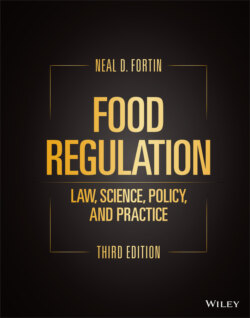Читать книгу Food Regulation - Neal D. Fortin - Страница 238
4.8 FDA’S FORTIFICATION POLICY
ОглавлениеFDA has written rules to established uniform set of principles for the rational addition of nutrients to foods.102 Desirable nutrient levels and quality in the food supply is an important public health objective. The uniform fortification of foods was one of the great public health achievements of the twentieth century, eliminating the nutrient deficiency diseases of pellagra, beriberi, rickets, and scurvy.
However, random fortification of foods could result in over‐ or underfortification and create nutrient imbalances in consumers’ diets. This could undermine the public health achievements through uniform fortification. It could also result in deceptive or misleading claims for certain foods.
As stated in the FDA’s fortification principles, “The Food and Drug Administration does not encourage indiscriminate addition of nutrients to foods, nor does it consider it appropriate to fortify fresh produce; meat, poultry, or fish products; sugars; or snack foods such as candies and carbonated beverages. To preserve a balance of nutrients in the diet, manufacturers who elect to fortify foods are urged to utilize these principles when adding nutrients to food… . The policy set forth in this section is based on U.S. dietary practices and nutritional needs and may not be applicable in other countries.”103
FDA finds fortification of certain listed nutrients may appropriately be added to a food appropriate under the following circumstances104:
to correct a dietary insufficiency recognized by the scientific community to exist and known to result in nutritional deficiency disease if the food is suitable vehicle for the added nutrients; or
to restore nutrient(s) to a level(s) representative of the food before storage, handling, and processing under good manufacturing practices.
The fortification rule lists a number of limits and controls, such as the food cannot be fortified in a way contrary to any other Federal regulation for a food or class of food that requires, permits, or prohibits nutrient additions (such as standards of identity), nutritional quality guidelines established in federal regulation, and common or usual name regulations. Adding a nutrient is also appropriate only when the nutrient is stable in the food under customary conditions of storage, distribution, and use; is physiologically available from the food; and the level will not result in an excessive intake of the nutrient.
